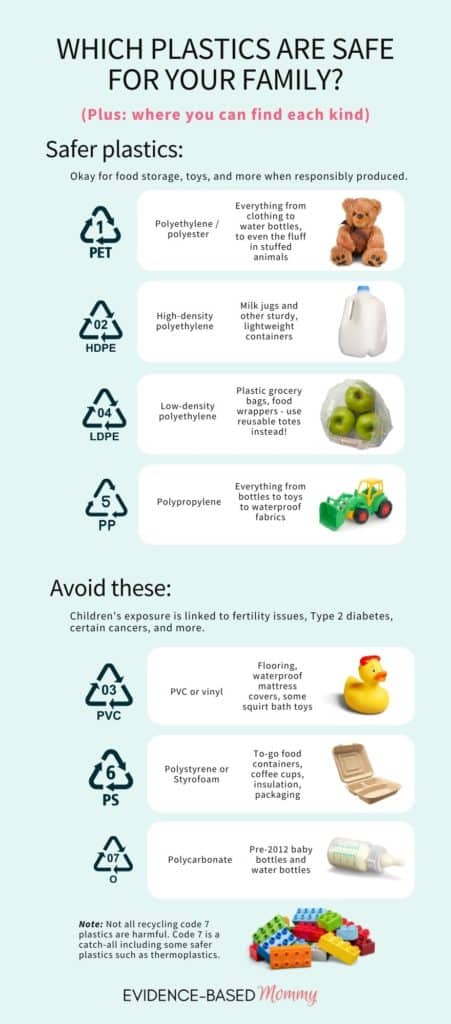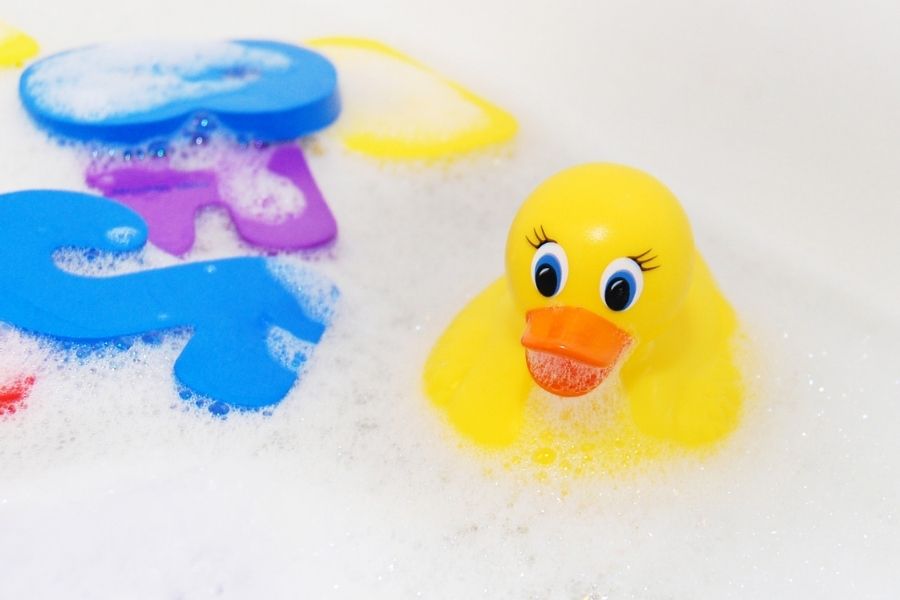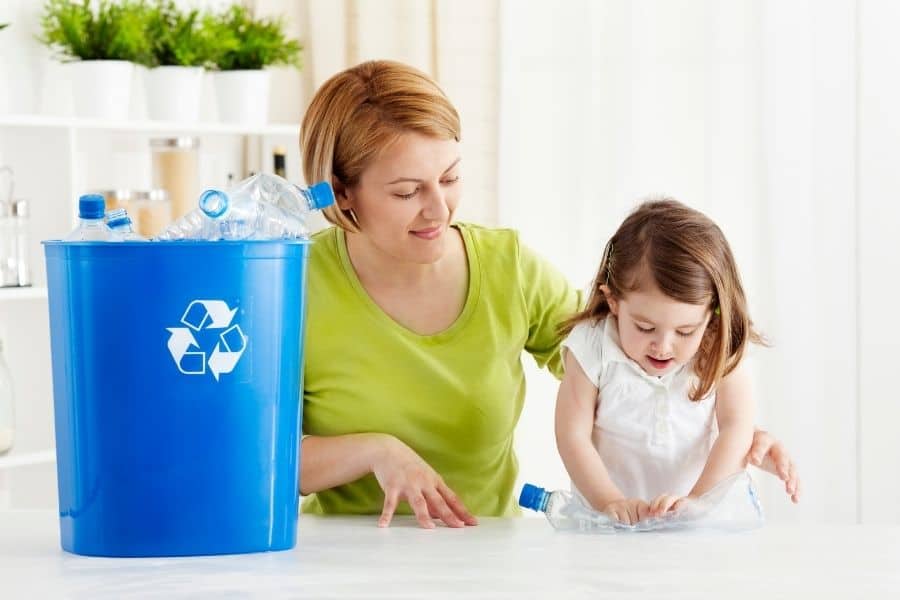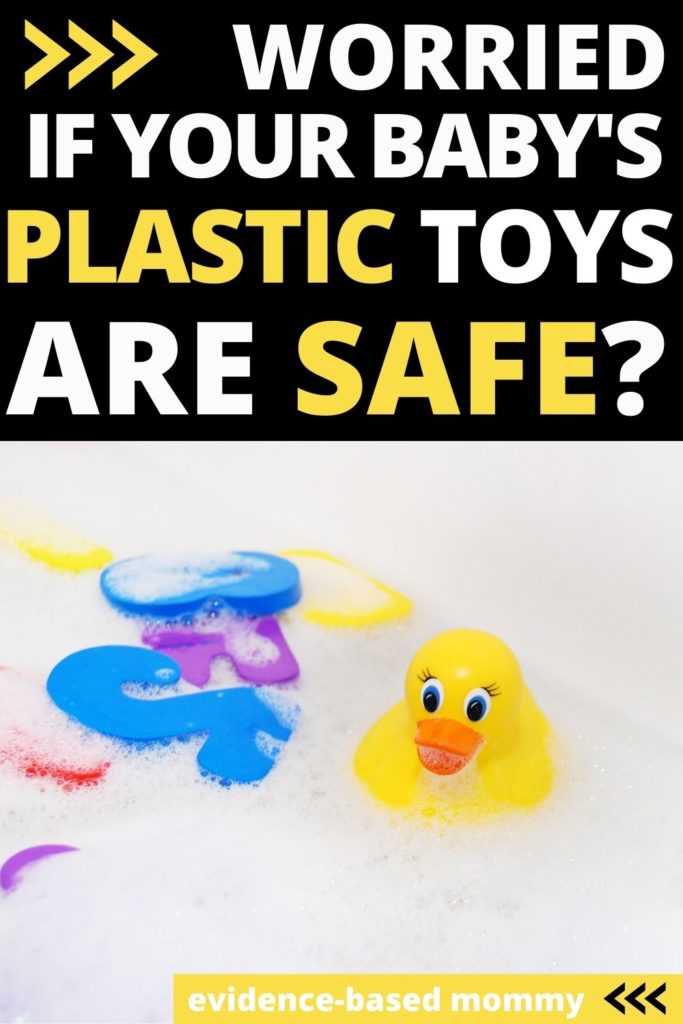You try to buy only the safest products for your kids, but you just aren’t sure what’s okay and what’s dangerous. But don’t worry! One of the easiest ways to protect your family is by reading recycling codes on the bottom of your plastic tubs, bottles, and children’s toys. These “plastic numbers” can help you find plastics that are safe (and which to skip).
Plastic is everywhere, from food containers to changing pads to crib mattresses. While we can’t completely avoid all man-made chemicals, we can make safer choices by knowing which plastics we’re using and what kinds of chemicals are in it.
Disclosure: This article contains affiliate links. As an Amazon Associate I earn from qualifying purchases. You can read my full policy here.
Fortunately, you can find out what kind of plastic a product is made from by looking at the recycling code on the bottom. In the States, all plastics are classified into 7 groups, which are designated by a number.
Since I have a PhD in exposure science (basically, what chemicals we’re exposed to and how they affect our health), I want to help moms protect their families and themselves from toxic chemicals. That’s why I’ve got this list that shows safe plastic numbers (and which to avoid).
Table of Contents
Why plastic can be dangerous
It can be hard to know which plastics are safe to use and which ones aren’t. All traditional plastics are made from petroleum, but different plastics are made using different chemicals from petroleum (and using different processes).
You can check out this safe plastic numbers chart to make it easy.

Some, but not all, plastics have additives like bisphenols, phthalates, and/or other “plasticizers” to increase flexibility or softness of the material. While these chemicals serve a purpose for industry, they can leach out of products over time.
Unfortunately, these chemicals are very toxic and cause long-term harm (particularly to the unborn and to young children). For example, bisphenol A (BPA) is an endocrine disruptor which has been used in the past in many food wraps, baby bottles, and the lining of canned foods. This chemical has been linked to everything from timing of puberty in children, to Type 2 diabetes, and even cancer later in life.
And even though BPA is no longer used in baby bottles, toys, and baby products, it is often replaced by compounds like bisphenol S (BPS), a related chemical that often isn’t tested for. BPS is also an endocrine disruptor, and may in fact cause even more damage. In fact, one review study says, “BPS was correlated with metabolic disorders, such as gestational diabetes, that BPS was not correlated with… [and] shown to be more toxic to the reproductive system than BPA…”
So even if you think you’re keeping your kids safe with that BPA free water bottle, you don’t know for sure without a little more information.
Which plastic numbers to avoid
Which plastic numbers are safe? Which ones should you avoid? Fortunately, you can glean a lot of information just by knowing the recycling code for an item. Here are the bad plastic numbers to avoid:
Recycling code 3: Polyvinyl Chloride (PVC or vinyl)
PVC is highly versatile and has lots of uses. It’s can be strong and hard (like in water pipes), or it can be moldable and flexible (like in the classic rubber duckie or other vinyl bath squirty toys). Plus, it’s waterproof, which is really helpful for crib mattress liners, changing pads, or other products that babies explode bodily fluids on.

Unfortunately, when heated or stressed (like when it’s chewed on by your teething baby), it can leach out phthalates or other harmful plasticizers. And crib mattress or mattress protectors can off gas toxic volatile organic chemicals (VOCs) over time.
RELATED: Best organic crib mattresses
RELATED: Best non-toxic toddler mattresses
While the most harmful phthalates have been banned in children’s toys in the United States by the Consumer Product Safety Comission (CPSC) since 2018, there could still be some phthalates or other plasticizers that are lurking in these toys. And you definitely don’t want to let your child play with and chew on your own old bath toys from when you were a kid.
One last note about vinyl: The production of PVC has huge negative environmental impacts as well. Producing PVC forms dioxins, some of the most toxic man-made substances. An accidental leak of dioxins at a chemical plant in Sevoso, Italy in 1976 was one of the most tragic human exposure events in history, and even now grandchildren of the town’s residents still have negative health effects.
Plastic code 6: Polystyrene (PS)
You often see polystyrene in the form of Styrofoam, holding your hot food takeout. While polystyrene works well for keeping your coffee hot, it can also can leach styrene, a possible human carcinogen. Plus, styrene leaches out worse with heat.
Switch to a mug or stainless steel thermos for your kid’s hot chocolate instead of a Styrofoam cup. It’s more fun that way anyways.
Plastic number 7: All others (including polycarbonate)
Recycling code 7 is a catch-all for basically any plastic that doesn’t fall into the other 6 categories. While some are fine, it’s best to avoid cod 7 plastics unless you know exactly what it’s made from. If you really must use a plastic item with code 7, check that it’s free of bisphenol-A, bisphenol S, phthalates, parabens, and other plasticizers.
One of the biggest offenders is polycarbonate, which contains BPA. This plastic was commonly used to make baby bottles up until 2012 (when the FDA finally banned BPA in baby bottles). With that said, be careful not to use old baby bottles or sippy cups for your own child.
Plastic numbers that are safe

Fortunately, there are several plastics that are much safer and even food-grade plastic. These are the safe plastic numbers you need to look for when reaching for products for yourself or your kids:
Plastic number 5: Polypropylene
Recycling code 5 is polypropylene, is one of the safest plastics. It is made from long chains of carbon and hydrogen (which if you remember from your chemistry class, is not reactive at all), meaning it doesn’t wreak havoc in your body. Plus, it’s resistant to damage from temperature fluctuations, making it best for food storage (including use in the freezer).
In fact, polypropylene is safe for baby. For this reason, polypropylene is used for everything from yogurt cups, baby bottles, and Tupperware. It’s also used for hard plastic toys (although toxicity isn’t the only consideration to make when choosing toys for your kids).
RELATED: Open-ended toys that encourage imaginative play
Recycling code 1: Polyethylene Terephthalate (PET or PETE)
Despite the name having the word “phthalate” in it, PETE does not contain phthalates. In fact, it’s often commonly known as polyethylene or polyester, and it’s another food-safe plastic, used for everything from water bottles to clothing.

PETE can be found in toys too. Polyfill is a form of PETE, so most of your child’s stuffed animals have polyethylene in them (and may even have polyester fiber in the fabric outside).
Note: While “virgin” PETE is free of phthalates and other plasticizers, recycled PETE may have these chemicals in it. So stay on the safe side and only use your disposable water bottle once before throwing it into recycling. And definitely don’t stick your water bottle in the freezer to cool it for later. Frozen water expands, leading to damage to the water bottle. As it melts, plasticizers can leach into your water, which you definitely don’t want.
Recycling code 2: High-Density Polyethylene(HDPE)
Recycling code 2 is another safe plastic with no phthalates or bisphenol-A. It’s strong yet lightweight, and can be found in milk jugs, shampoo bottles, and detergent containers.
Much like polyethylene, all-new HDPE is used for food storage containers, while recycled HDPE is used for other applications like plastic flowerpots.
Recycling code 4: Low Density Polyethylene (LDPE)
Recycling code 4 is LDPE, a lightweight and flexible plastic. It’s ideal for certain food storage applications like deli meat wraps and cling wrap (Fun fact: Have you ever thought that cling wrap just isn’t as clingy as it used to be? That’s because when we were kids, PVC was used for clingwrap instead of LDPE. Yikes). You can also find LDPE in squeezable bottles that use natural oils or lotions.
While LDPE is safe for human health and cheap, it’s important to remember the environmental impact of it. Those plastic grocery bags? They’re made of LDPE, and they don’t break down in the environment. As a result, they’re overfilling landfills and even causing issues in the ocean.
Be sure to recycle your grocery bags. Even better, get a few reusable grocery totes like this pack of 3.
Safe plastic number 7 options: PLA, thermoplastics, and Tritan
You may be wondering, “Is number 7 plastic safe?” Even though I warned about polycarbonate above, there are some safe plastics under recycling code 7. These include polylactic acid (PLA), Tritan, and thermoplastics.
PLA is a newer plastic that is biodegradable. It’s made from corn, soy, or other another renewable feedstock, instead of petroleum. PLA is great for packing materials or dry food packaging.
Tritan is a tough, clear plastic, often used in water bottles (think Camelbak bottles) or children’s plates and food storage bowls. While Tritan claims it’s free of BPA, there have been claims that this plastic may contain endocrine disruptors. However, since these water bottles are designed for cool (not frozen) water, there should be little problem with leaching.
Thermoplastics like acrylonitrile butadiene styrene (ABS) are free of plasticizers and easy to mold. They’re used for 3D printing and even for Legos.
BPA free numbers on bottles
If you’re looking for baby bottles that are safe, it’s good to know what to look for. Polypropylene baby bottles (plastic 5) are safe, and modern bottles are generally made from polypropylene.
Be careful about plastic 7 bottles. If they’re older, they are likely made of polycarbonate and contain BPA and/or BPS. Get rid of these.
With that said, plastic 7 bottles made of Tritan are safer (but they seem to be less common). Given that there’s less certainty around Tritan and breastmilk / formula is heated slightly before serving, I would suggest sticking with polypropylene.
Conclusions on safe plastic numbers
As we said, it’s impossible to avoid plastics. However, there are many actions you can take to keep your family as safe as possible:
- Avoid heating food in plastic containers – use glass instead.
- Get rid of your old plastic toys (especially baby toys) from the early 2000s and before. These are most likely to contain estrogenic compounds.
- Get rid of baby bottles made before 2012.
- Make sure your mattresses, mattress protectors, and diaper changing pads aren’t made with vinyl.
- Don’t store fatty foods or acidic foods (think cream sauces or tomato soup) in plastic containers. Endocrine disrupting compounds are more likely to leach out into these foods.
- Say no to grocery store shopping bags and get some reusable totes for groceries.
I hope this list helps you make safer choices in your everyday life. By making smarter decisions, we can live healthier and happier lives for ourselves and our families. If you have a question about a plastic not listed here, please let me know.




Thanks for the great article and helpful information. I’m a bit confused though, because I’ve seen elsewhere that #2 and #4 items can still contain traces of BPA – if an item is not made of recycled plastic, do I not need to worry?
Hi Sophie,
There are ways to sort recycled plastic to make sure that they aren’t mixed – for example, that you don’t accidentally get some polystyrene into polypropylene. While it’s possible that there can be small traces of BPA in #2 or #4 plastic, it’s MUCH less likely than for polystyrene or PVC. And, virgin safe plastics are going to be even less likely to have BPA than recycled plastic. I hope this helps!
Thank you for the information! What about Bioplastics? Are they safe? I am looking for a super safe ball pit for my baby girl not sure what’s safer Polyethylene or Bioplastics.
Hi Kate, it unfortunately has to do with whether they use any plasticizers that are endocrine disruptors in the bioplastics. Polyethylene doesn’t require plasticizers.
Hi,
is polyethelene safe when in cold water?
Yes! Thanks for checking.